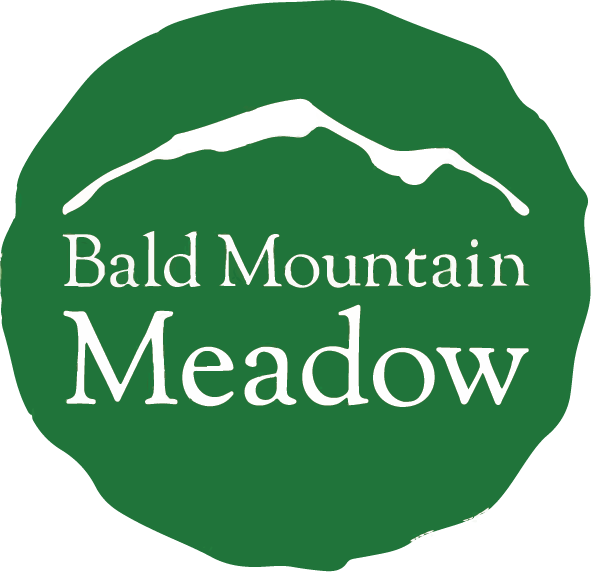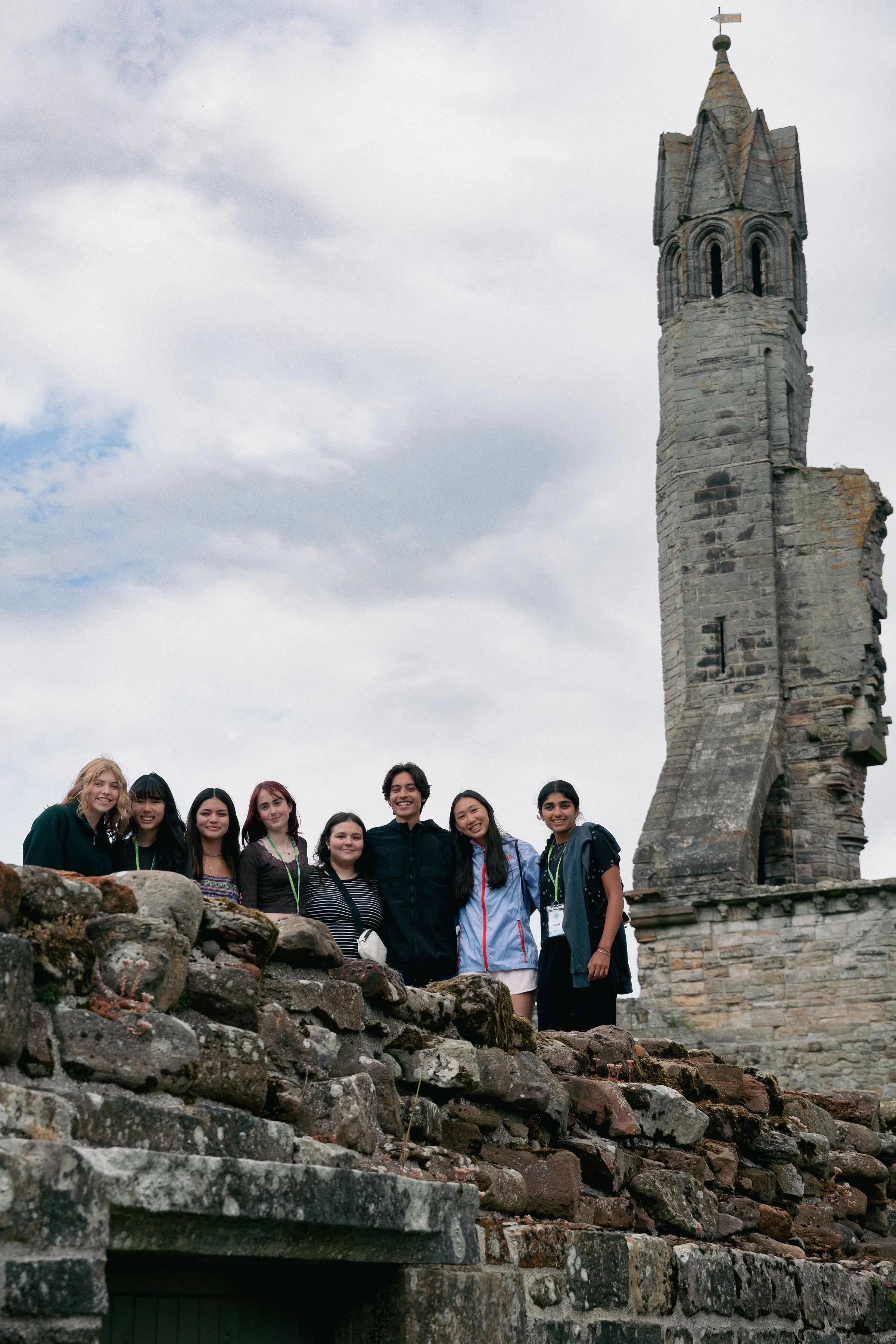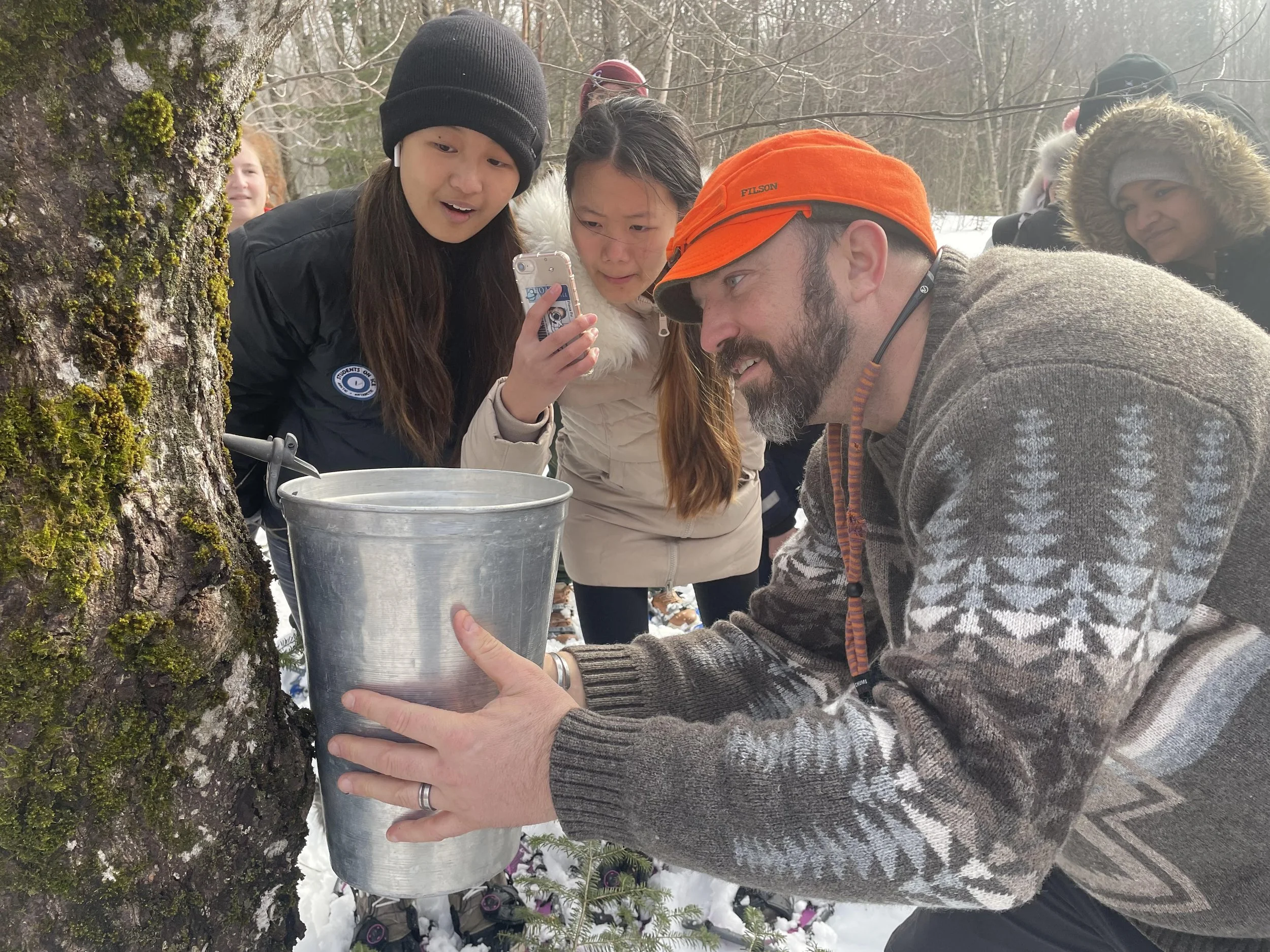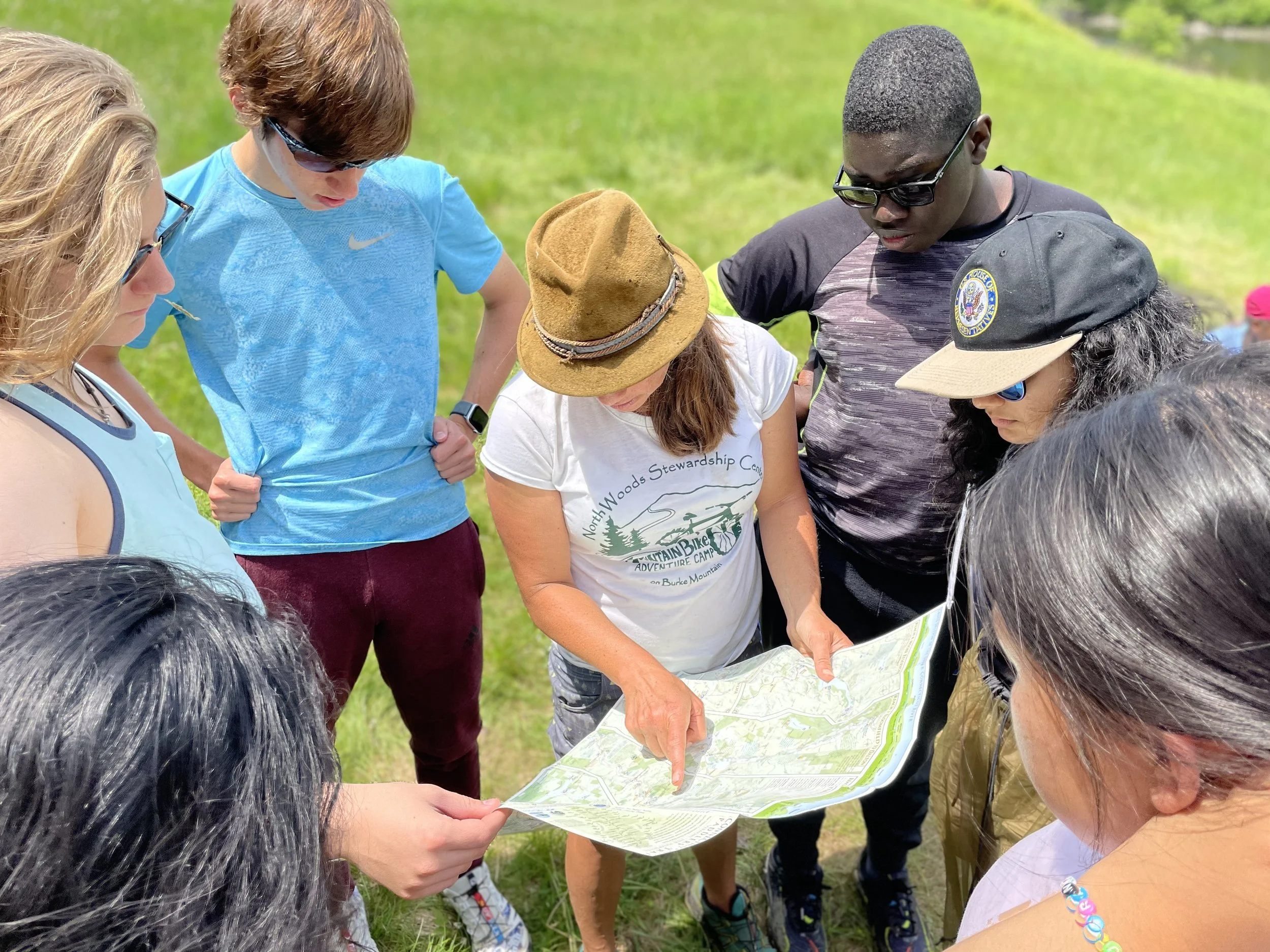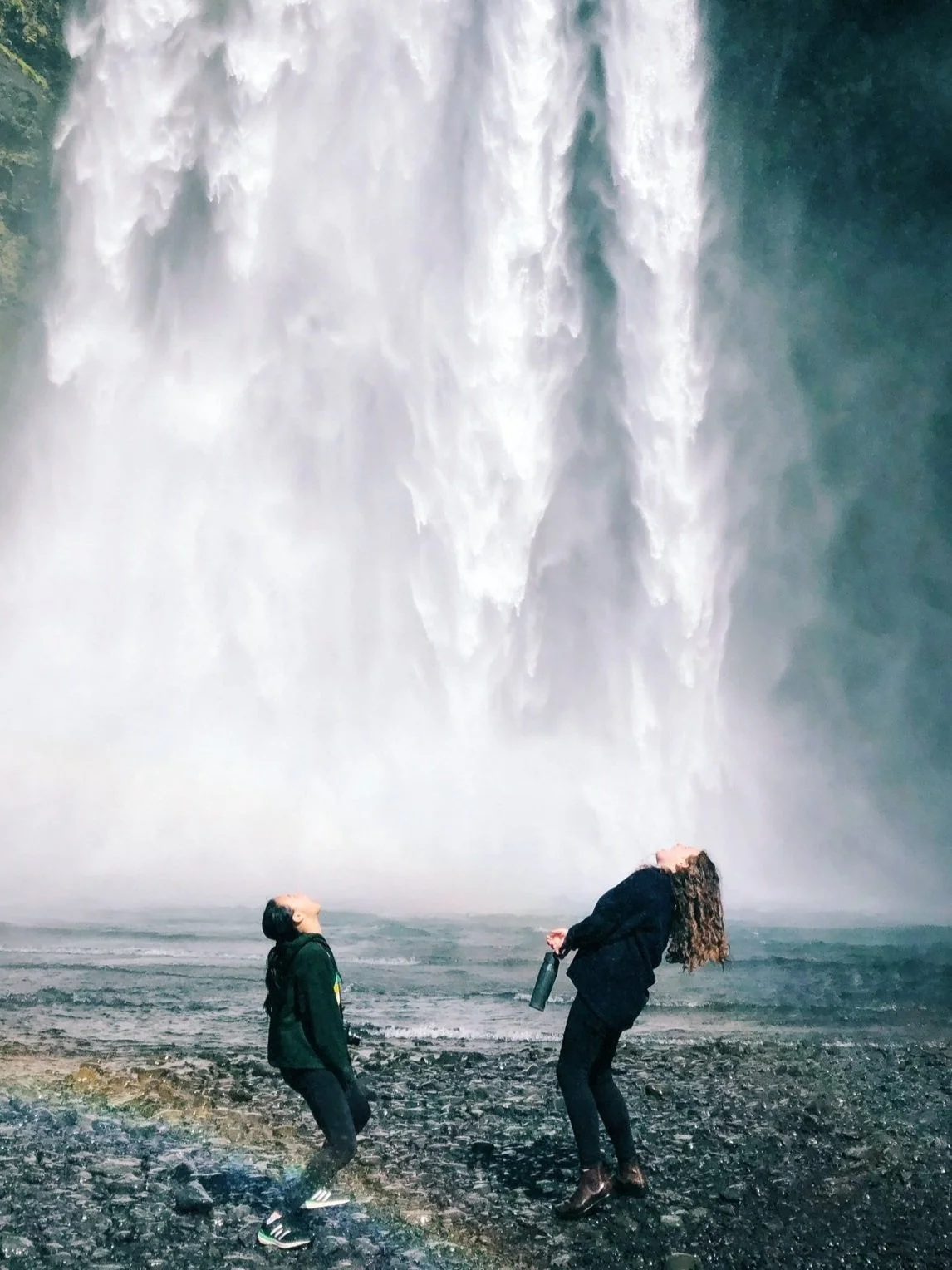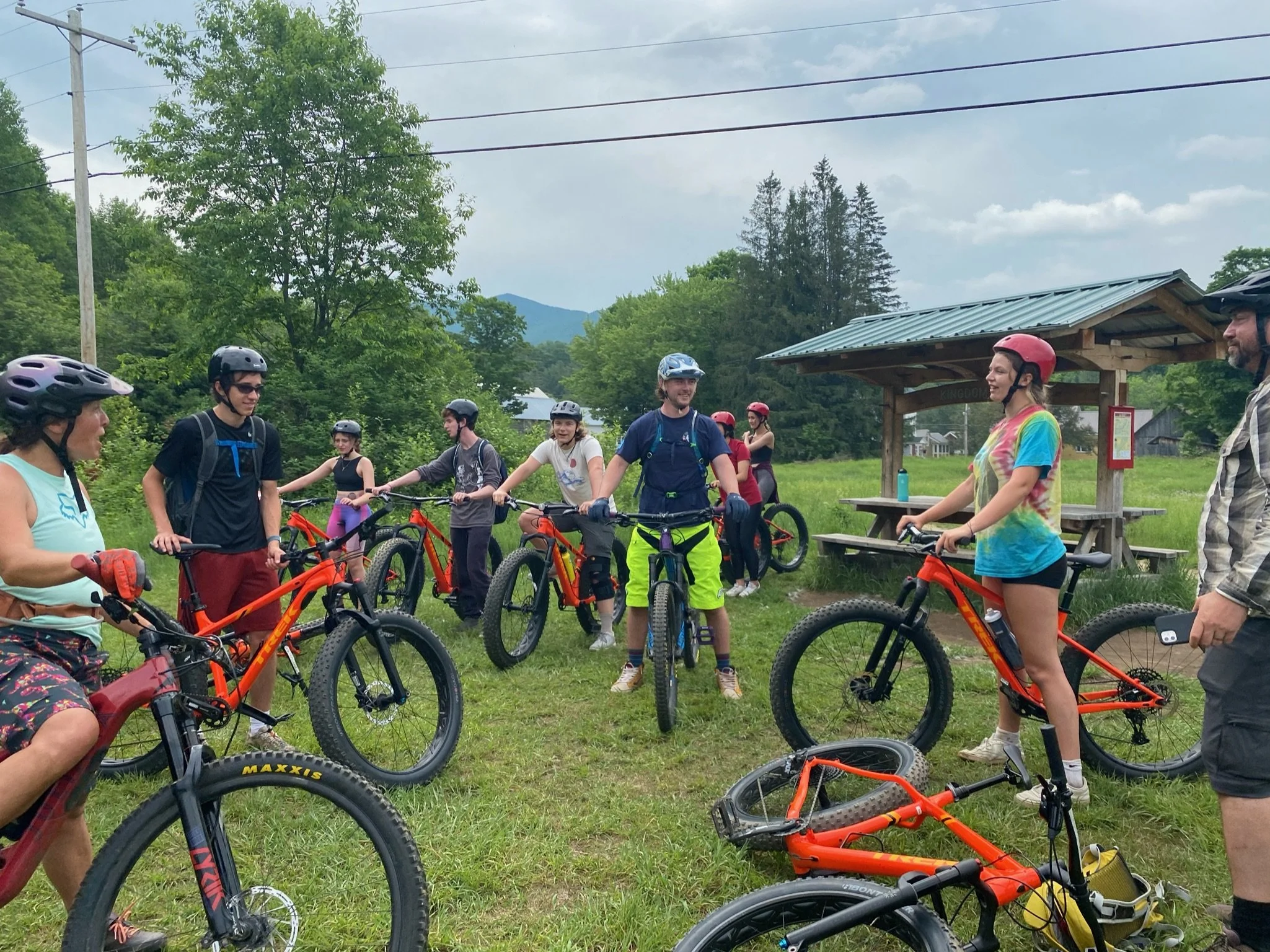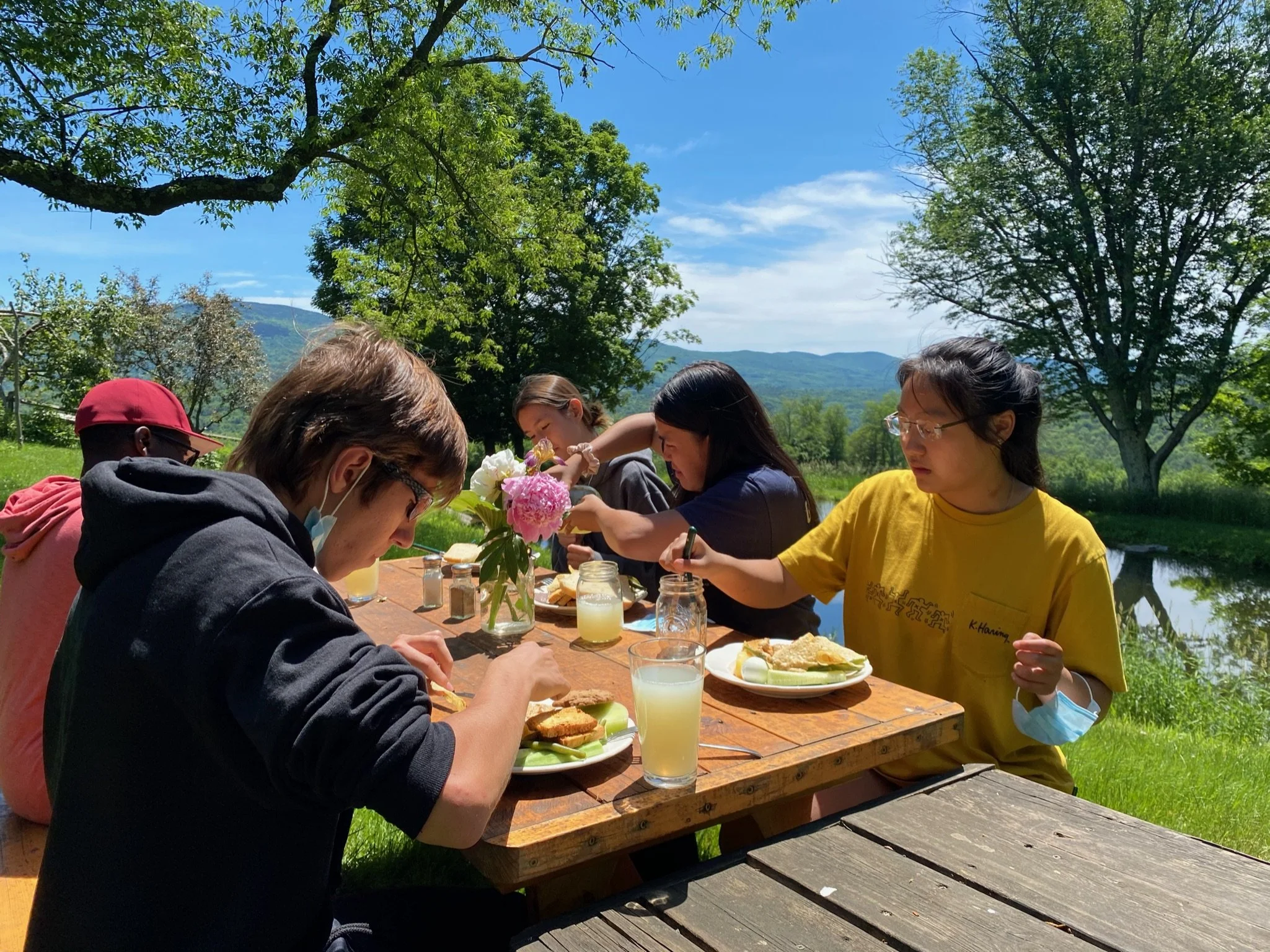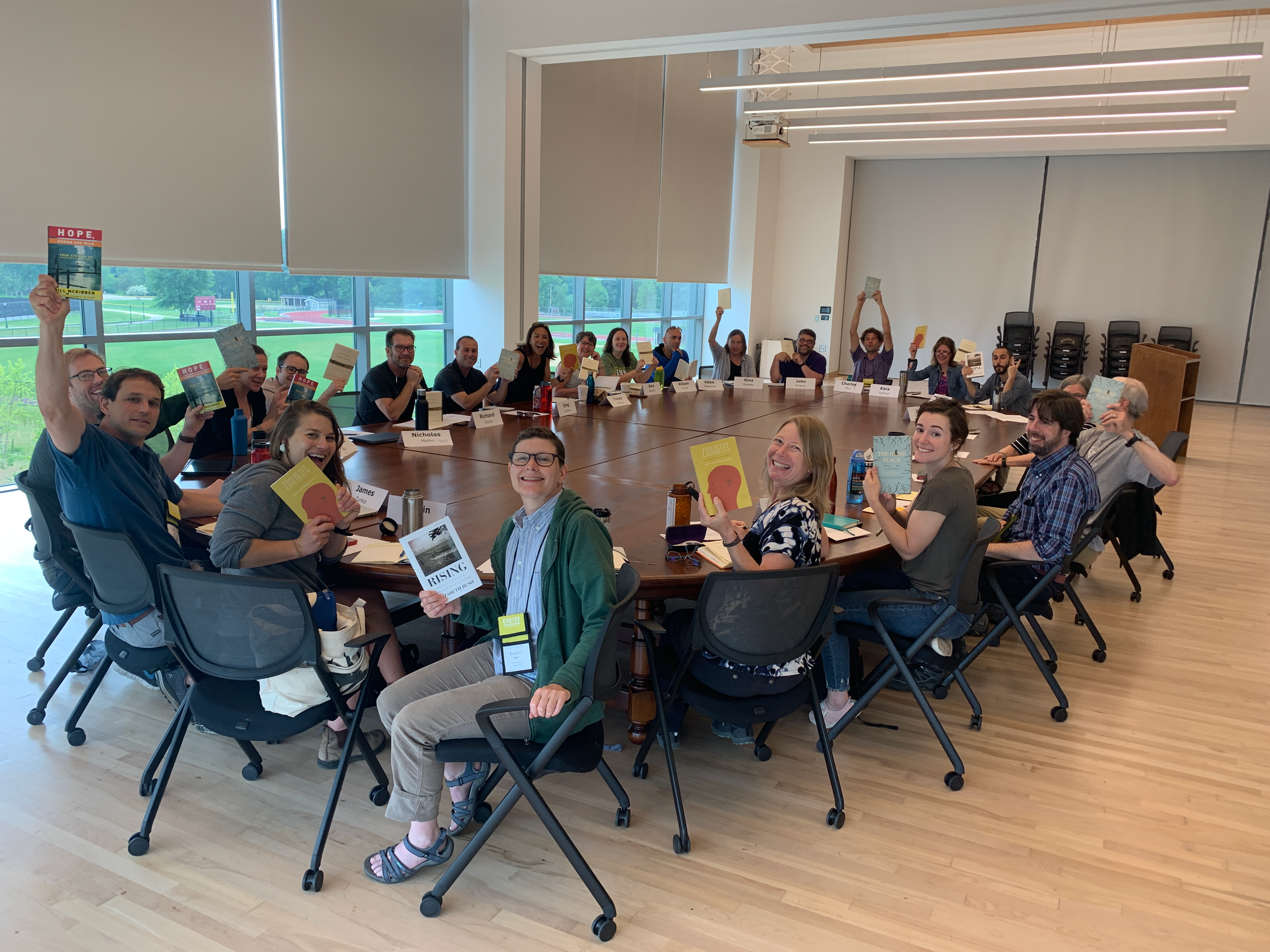Check out our interdisciplinary environmental learning expeditions for students and our professional development programs and resources for educators.
Programs for Students
Interested in creating a program for your students? Check out our portfolio of student programs for inspiration and/or start a conversation.
2025 Gci FELLOWSHIP
This year-long program in ethical and effective global leadership kicks off with a 9-day summit in St Andrews, Scotland and culminates in the creation of “Glocal” Service Project in your home community.
2025 GCI Fellowship
Bald Mountain Meadow has partnered with Global Citizens Initiative to lead the 2025 GCI Fellowship. The program begins as 30 students from around the world gather at the University of St Andrews, Scotland for a 9-day immersion in discussion-based learning, design thinking, and human connectivity. An international team of faculty and speakers bring a diverse set of experience and approaches to creating positive change. Excursions along the Scottish coastline deepen our students connection to each other and to the place-based case studies in effective leadership and change-making to inspire new ways of addressing global issues at a local level. Students will workshop their individual plans for a “glocal” service project (GSP) in their home communities within the rigorous think tank created by our vibrant learning community.
Once students return home, they continue virtual sessions with GCI faculty and coaches to bring their GSPs to fruition. Each class of Fellows joins the vibrant, lifelong community of GCI Ambassadors leading change across the globe.
For more information and to apply, please click here.
Headwaters to Home: A Bioregional Learning Expedition in the ConnecticuT RiVER WATERSHED
Dubbed the “long tidal river” by the Indigenous peoples of southern New England who lived and traveled on it, the Connecticut River is the longest river in New England.
Headwaters to Home: A Bioregional Learning Expedition in the Connecticut River Watershed
Dubbed the “long tidal river” by the Indigenous peoples of southern New England who lived and traveled on it, the Connecticut River is the longest river in New England, stretching more than 400 miles from the northern tip of New Hampshire, through Vermont, Massachusetts, and Connecticut on its way to Long Island Sound. For thousands of years, the Connecticut River’s resources have attracted inhabitants who have shaped the surrounding area in complex ways--sometimes for good, but often for ill. Today, the river flows in proximity to more than 2.4 million residents and over 400 communities, and many of us who call New England home consider it the most prominent ecological feature of our region. On this ten-day paddling trip, students and teachers will encounter the Connecticut River watershed, learn about its cultural and ecological histories, and begin to imagine how these stories can help map a better path forward through the challenges of the Anthropocene.
After a three-day orientation at Quimby Country Cottages in Vermont’s Northeast Kingdom, the group will depart the river’s headwaters by canoe, paddling south until we arrive back at Loomis Chaffee--at home. This interdisciplinary learning expedition will include days spent paddling and learning and nights spent sleeping alongside the river. As we paddle, we will encounter the river firsthand, engaging with the complex narratives it tells. Our stops along the way will include prominent sites and conversations with local experts in art, geology, hydrology, and Indigenous history and culture. These experts will help us contemplate how a river creates a living place and how people have made a home beside it. By the time we pull our boats out of the water back on campus, we will have developed an intellectual, emotional, and embodied understanding of this watershed as both an ecological entity and a metaphor for something larger--a paradigm for living well in a place wherever we go.
Get Inspired!
PORTFOLIO of student Programs
Spring Break in Maple Nation: SUGARING IN VERMONT’S NORTHEAST KINGDOM
Are you looking for a truly distinct New England experience for spring break? Spring Break in Maple Nation revels in the ancient New England tradition of creating maple syrup.
Spring Break in Maple Nation: Sugaring in Vermont’s Northeast Kingdom
Are you looking for a truly distinct New England experience for spring break? Spring Break in Maple Nation revels in the ancient New England tradition of creating maple syrup.
The Abenaki believe maple sap is one of mother earth’s profoundest gifts, that from winter’s deepest darkness, when the threat of starvation loomed real, the earth gave to the people the gift of running sap, of sweet sustenance from the trees. During this trip, students will learn about the Abenaki history of sugaring as a model for a deeply-connected and sustainable relationship to a place. We’ll also examine various economic models that define the sugaring industry today, from small-scale “mom and pop” operations to the more controversial industrial-scale operation, Sweet Tree Holdings, the largest maple sugar operation in the world. Finally, we’ll try our hand at making our own syrup, working at Bald Mountain Meadow to tap trees, collect sap, and boil it down for syrup to enjoy on our pancakes, in our coffee, and in other recipes we concoct!
Along the way, we’ll meet and interact with various scientists, artists, educators, and entrepreneurs--all experts who will teach us the ins and outs of maple sugaring while helping us think through the nuances of its related complexities. How does climate change project the demise of the local sugaring industry, and what might a place do in the absence of one of its core regional signifiers? How does indigenous wisdom of er a paradigm for a sustainable future? Students will think deeply about these and other questions, about their relationships to the natural world, about how communities are linked to their landscapes, and about how our landscapes can feed us physically and spiritually. Sitting around the fire, breathing the sweet aroma of boiling sap, we will experience firsthand the particular magic of sap season.
And while the snow lasts, we’ll find other ways to celebrate the glories of late winter in Vermont. Sledding. Cross country skiing. Snowshoeing, Fat-tire biking. Our days will begin mid-morning, so participants can rest and recover after their winter term, and we’ll build in other enjoyable experiences to complement our sugaring –a trip to Burlington, for example; excursions to Local Donut and Galaxy Bookstore in Hardwick; a visit to Greensboro’s Highland Center for the Arts.
Writing Wild: A Place-Based Writing Enrichment Workshop
This week-long writing enrichment program in Vermont’s Northeast Kingdom leverages the power of place to help students to explore their own identities and develop powerful skills as writers.
Writing Wild: A Place-Based Writing Enrichment Workshop
This week-long writing enrichment program in Vermont’s Northeast Kingdom leverages the power of place to help students to explore their own identities and develop powerful skills as writers. Hosted at a beautiful wilderness camp on Job’s Pond in Westmore, VT, students will engage in a variety of experiences designed to galvanize and inform their writing: hiking, camping, swimming, canoeing, mountain-biking, community-building. As they experience the land and the culture that arises from the land, students will participate in classes and workshops and attend literary readings designed to grow their skills as writers. And students will write, write, write--learning and practicing a breadth of skills that will make them more confident and self-reflective writers. Students on this trip will:
Read texts by a diverse range of authors who challenge them to think critically and curiously about writing and about their place in the more-than-human world
Embrace a process-based mentality rather than a product-based mentality
Experiment with and reflect on different writing processes as they find one that works for them
Hone their own voices as writers by incorporating into their writing various experiences and dimensions of their identities
Pursue an idea from an initial draft into a more fully realized piece
Share their writing with each other, both on the page and aloud
Experience moments of joy, delight, curiosity, and wonder in the act of writing
Cultivate a supportive community of writers that invites them to take intellectual risks
By the end of the week, students will emerge as far more competent and confident writers. Each student will produce one fully realized piece that they are excited to share with others. They will have thought deeply about both their approach to craft and their relationship to place--habits of mind that will travel with them back to campus and beyond.
Land of Ice and Fire: People and Places of Iceland
Jumpstart students will have an opportunity to immerse themselves in Icelandic history and culture while studying climate change and related environmental issues through the dual lenses of science and the humanities. Iceland is a fascinating place for a number of reasons—for the depth of its history and culture, for the uniqueness of its natural resources, and for its location on the frontlines of many climate change impacts.
Land of Ice and Fire: People and Places of Iceland
Students on this trip will have an opportunity to immerse themselves in Icelandic history and culture while studying climate change and related environmental issues through the dual lenses of science and the humanities. Iceland is a fascinating place for a number of reasons—for the depth of its history and culture, for the uniqueness of its natural resources, and for its location on the frontlines of many climate change impacts.
We will explore both the culture and the landscape of Iceland and how the two are intertwined. Students will also learn about the ways in which Iceland is being affected by global environmental issues, climate change in particular. By discovering this deep sense of place in Iceland, students will leave the trip with a new ability to see those connections—between culture and nature, between humans and place—in their own communities. Moreover, students will gain a sense of how climate change is affecting both human culture and the natural world, and will bring that awareness to their continued studies at home, and beyond.
Over the course of this trip, students will visit a variety of important cultural and natural sites; they will interact with various experts, authors, and filmmakers; and they will engage in multiple adventures that will involve building collaborative skills and leadership abilities. Throughout the trip, students will also have opportunities to encounter various texts, like M Jackson’s The Secret Lives of Glaciers and Sjon’s The Blue Fox, and documentary films like “Ok”, “Chasing Ice”, and “Tomorrow” that will enhance their experiences on the ground and give them a sense of how Iceland has been represented historically and in the present day.
environmental stewardship in Vermont
Vermont: Our smaller, crunchier neighbor to the west, located just across the Connecticut River, is fall foliage and spring maple sugar. But there’s more going on here than just postcard New England.
Environmental Stewardship in Vermont
Our smaller, crunchier neighbor to the west, located just across the Connecticut River, is fall foliage and spring maple sugar. But there’s more going on here than just postcard New England. Vermont is a place of deep connection to the rhythms of the natural world, a place of close communities living close to the land. Vermont asks those who visit it to think more deeply and with greater inspiration about the possibilities that exist for living well in the midst of today’s challenges, in short, to think about how to be a better steward. Robin Kimmerer, in her seminal work Braiding Sweetgrass, describes this sense of reciprocity as “mutual flourishing,” suggesting that there is a way to be in the world where the human and nonhuman worlds can thrive in concert. But what does this mutual flourishing actually look like, and what does it feel like to live it?
Using Quimby Country Cottages in Vermont’s Northeast Kingdom as a hub for our experiences and conversations, we will explore and live the idea of stewardship through the contexts of recreation and adventure, community and food, and the arts and sciences. Come mountain bike the famed Northeast Kingdom Trails while thinking about forestry management and ecotourism. Spend a day in the sun at Bald Mountain Meadow tending a garden while discussing sustainable agriculture, renewable energy, and community resilience. Hike to the summit of Bald Mountain for its 360-degree views of the Clyde River Valley, or paddle the Connecticut River and cast a line as you contemplate land-use history and climate change. Heft a rockbar with renowned Vermont writer Sean Prentiss while discussing his book Crosscut and the concept of wildness it explores. Our conversations and experiences will be myriad and informed by intentional encounters with Vermont and its people. In the end, you will emerge with a deep sense of place, of Vermont, and a template for engaging your own homes in ways that offer mutual flourishing to human and nonhuman communities wherever you find them.
Into Place with Bald Mountain Meadow and Hotchkiss’ Bridge Program
By sharing the story of northwestern Connecticut’s bioregion; and by giving students powerful firsthand encounters with their new home, this program will nurture a sense of belonging in students that will ground them as they navigate their Hotchkiss careers.
Into Place with Bald Mountain Meadow and Hotchkiss’ Bridge Program
Into Place is a three-day guided orientation for Hotchkiss students participating in the school’s Bridge Program. By creating a sense of welcoming and community; by sharing the story of northwestern Connecticut’s bioregion; and by giving students powerful firsthand encounters with their new home, this program will nurture a sense of belonging in students that will ground them as they navigate their Hotchkiss careers.
The program is designed to be gentle and welcoming in terms of the rigor of the outdoor experiences it affords–activities like team building exercises, fireside conversations, flatwater paddling, and hiking will help students make connections and gain trust. In this way, students will enter their Hotchkiss careers with an emerging sense of place, equipping them with the awareness of how they fit within that story, and the confidence to move forward with empathy, power, and grace.
Into Place is grounded in the practices of joy and connection–to place, to each other, and to community. In the end, students will begin to learn the story of this new place they will call home, creating a trove of positive new memories that will help it become theirs.
Rooted in Place: Practicing Wellness in Vermont’s Northeast Kingdom
Vermont is a place of deep connection to the rhythms of the natural world, a place of close communities living close to the land. And Vermont asks those who visit it to think more deeply and with greater inspiration about the possibilities that exist for living well in the midst of today’s challenges, for living well in place.
Rooted in Place: Practicing Wellness in Vermont’s Northeast Kingdom
Vermont is a place of deep connection to the rhythms of the natural world, a place of close communities living close to the land. And Vermont asks those who visit it to think more deeply and with greater inspiration about the possibilities that exist for living well in the midst of today’s challenges, for living well in place. Hosted at a beautiful wilderness camp on Job’s Pond, in the heart of Vermont’s Northeast Kingdom, students on this trip will explore various paradigms for wellbeing and contemplate the ways in which a relationship to place often elicits a wellspring of wellness. Food. Adventure. Art. Ecology – these will be the lenses through which students will consider their relationship to place. Students will mountain bike the famous Kingdom Trails, swim in Lake Willoughby, and hike Bald Mountain; visit with local farmers and cook together with ingredients sourced from the immediate vicinity; engage with local artists like Bread and Puppet theater and Thompson Timber Framing and use those encounters to inspire their own artistic expressions; engage in wellness practices like yoga, meditation, and journaling at Bald Mountain Meadow. We’ll also make time for deliberate reflection, seeking to be present with these encounters and the ideas they stir. In this wild, remote landscape, students will deepen their connections to the land and its people, to one another, and, ultimately, to themselves.
Programs for Educators
Teaching Climate Justice: A Workshop Series for Teachers
A professional development series for educators introducing environmental justice supports related curriculum development.
Teaching Climate Justice: A Workshop Series for Teachers
What we will provide:
In-depth instruction in various approaches to climate education, and specifically climate justice education
Individualized coaching to develop climate justice project-based units
Strategies to support teachers and students in navigating the emotional dimensions of this material
Access to CCE’s suggested collection of supporting resources
Opportunities to learn from outside speakers, including authors, activists, and educators
By the end of this series of workshops, participants will have gained the confidence and skills to be a climate justice educator and will be able to:
Explain basic concepts and terms related to climate change and specifically to climate justice (e.g. feedback loops, environmental racism, climate gentrification)
Articulate the intersections and parallels between the harms of racism and harms of climate change
Reflect on their own relationship/connections to climate change
Implement strategies for nurturing student and teacher wellbeing and mental health in the context of climate justice
Devise their own project-based unit focused on climate justice
Workshop Session 1
Locating ourselves and each other in this work ● Introducing key terms, frameworks, and histories of climate justice ● Setting goals and identifying questions for unit development and personal/community growth ● Pedagogical practice 1: Introducing students to climate change in the humanities and/or sciences ● Pedagogical practice 2: Pointing to examples of youth resilience and resistance in an age of climate change
Workshop Session 2
Deepening our understanding of climate injustice, racism, and settler colonialism by listening to the voices of frontlines communities ● Practicing mindfulness and engaging in personal reflection to grapple with the emotional impacts of teaching climate change ● Pedagogical practice 1 : Using role play activities to help students grapple with the breadth and interconnection of climate impacts ● Pedagogical practice 2: Using storytelling projects to help students locate climate justice issues in their own communities ● Pedagogical practice 3: Teaching the literature and history of climate justice
Workshop Session 3
● Unpacking case studies in climate justice and considering the ways in which climate impacts intersect with existing social inequities. ● Practicing the “teleconnected imagination” by considering how a particular environmental or social issue, perhaps one relevant to Vermont or New England more broadly, is connected to climate justice ● Pedagogical practice 1 : Constructing interdisciplinary climate justice case studies that focus on locally-relevant issues ● Pedagogical practice 2: Helping students and teachers grapple with climate anxiety, despair, grief, outrage.
Workshop Session 4
● Exploring the ways in which individuals and communities around the world are fighting for climate justice and constructing a more just, sustainable, and equitable world ● Pedagogical practice 1: Strategies for cultivating student imagination by using games and other interactive texts that foster future-oriented thinking ● Pedagogical practice 2: Strategies for cultivating student agency by developing community-engaged projects and bringing activism into the classroom
Workshop Session 5
Workshop Session 5: ● Building our units and sketching out classroom practices Filling in the gaps ● What’s next? What do you need moving forward? ● Pedagogical practice: Sharing out our in-progress units
Interested in creating a program for educators? Let’s build together.
